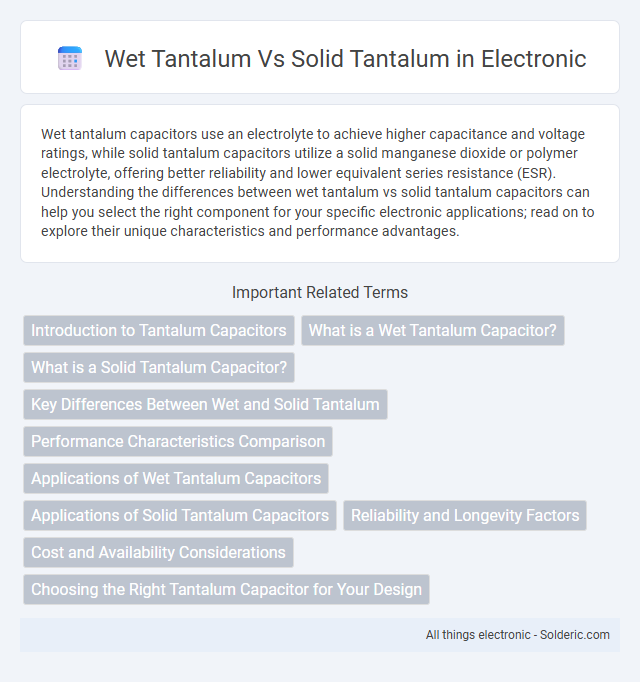Wet tantalum capacitors use an electrolyte to achieve higher capacitance and voltage ratings, while solid tantalum capacitors utilize a solid manganese dioxide or polymer electrolyte, offering better reliability and lower equivalent series resistance (ESR). Understanding the differences between wet tantalum vs solid tantalum capacitors can help you select the right component for your specific electronic applications; read on to explore their unique characteristics and performance advantages.
Comparison Table
| Feature | Wet Tantalum | Solid Tantalum |
|---|---|---|
| Construction | Electrolyte-soaked porous tantalum anode | Solid tantalum metal anode |
| Capacitance | Higher capacitance per volume | Lower capacitance compared to wet tantalum |
| Voltage Rating | Typically lower voltage rating (6.3V to 50V) | Higher voltage rating possible (up to 100V+) |
| ESR (Equivalent Series Resistance) | Low ESR | Moderate ESR |
| Leakage Current | Generally higher leakage current | Lower leakage current |
| Reliability | Less robust, electrolyte drying can cause failure | More reliable, solid electrolyte avoids drying issues |
| Applications | Audio circuits, power supply smoothing | High-voltage circuits, aerospace, military |
| Size | Compact for given capacitance | Typically larger for similar capacitance |
Introduction to Tantalum Capacitors
Tantalum capacitors are electronic components that utilize tantalum metal to achieve high capacitance and reliability in compact sizes. Wet tantalum capacitors contain a liquid electrolyte, offering high voltage ratings and improved stability in demanding applications, whereas solid tantalum capacitors use a solid manganese dioxide or polymer electrolyte, known for lower ESR and enhanced performance in low-voltage circuits. The choice between wet and solid tantalum capacitors depends on specific requirements such as voltage, size, and application environment in electronic devices.
What is a Wet Tantalum Capacitor?
A wet tantalum capacitor is an electrolytic capacitor that uses a liquid electrolyte to enhance capacitance and reliability. Unlike solid tantalum capacitors, wet tantalum types offer higher capacitance values and improved performance in high-voltage applications due to their liquid electrolyte's superior conductivity. Your choice between wet and solid tantalum depends on specific requirements such as voltage rating, capacitance, and expected operating environment.
What is a Solid Tantalum Capacitor?
A solid tantalum capacitor utilizes a solid manganese dioxide or conductive polymer as the electrolyte, offering high capacitance per volume and excellent stability under varying temperatures. Unlike wet tantalum capacitors that contain a liquid electrolyte, solid tantalum capacitors provide superior reliability, lower equivalent series resistance (ESR), and enhanced frequency characteristics. These capacitors are widely used in aerospace, medical devices, and portable electronics due to their compact size and long operational lifespan.
Key Differences Between Wet and Solid Tantalum
Wet tantalum capacitors utilize a liquid electrolyte allowing higher capacitance and better performance at high temperatures compared to solid tantalum capacitors, which use solid manganese dioxide or polymer electrolytes. Solid tantalum capacitors offer superior long-term stability, lower equivalent series resistance (ESR), and enhanced reliability in applications requiring compact size and low leakage current. The choice between wet and solid tantalum capacitors depends on factors such as capacitance requirements, operating conditions, size constraints, and cost efficiency in electronic circuit designs.
Performance Characteristics Comparison
Wet tantalum capacitors exhibit higher reliability and longer lifespans due to their electrolyte, which provides self-healing properties and better tolerance to voltage spikes, making them ideal for high-stress environments. Solid tantalum capacitors, while offering lower Equivalent Series Resistance (ESR) and stable performance at high frequencies, tend to be more sensitive to surge currents and less forgiving under voltage stress. Your choice depends on whether you prioritize robustness and durability in harsh conditions (wet tantalum) or compact size with superior high-frequency performance (solid tantalum).
Applications of Wet Tantalum Capacitors
Wet tantalum capacitors are widely utilized in aerospace, military, and industrial applications due to their high capacitance, reliability, and ability to operate at extreme temperatures and voltages. These capacitors excel in power supply filtering, energy storage, and pulse power circuits where high surge current tolerance and stability are critical. Compared to solid tantalum capacitors, wet tantalum options offer superior performance in harsh environments, making them ideal for mission-critical systems requiring long lifespans and robust electrical characteristics.
Applications of Solid Tantalum Capacitors
Solid tantalum capacitors are widely used in aerospace, military, and medical device applications due to their superior reliability and stability under extreme conditions. These capacitors offer high volumetric efficiency and excellent capacitance stability, making them ideal for power supply filtering, timing circuits, and sensitive signal processing. Their robust construction allows them to withstand high surge currents and temperature variations, ensuring long-term performance in mission-critical environments.
Reliability and Longevity Factors
Wet tantalum capacitors exhibit higher capacitance and better temperature stability but face potential reliability challenges due to electrolyte drying and leakage over time. Solid tantalum capacitors, using a manganese dioxide or polymer electrolyte, provide enhanced longevity and consistent performance under high-stress conditions, reducing the risk of catastrophic failure. The choice between wet and solid tantalum hinges on specific application requirements emphasizing durability and long-term reliability.
Cost and Availability Considerations
Wet tantalum capacitors generally offer lower cost and higher availability due to their simpler manufacturing process and widespread use in legacy electronics. Solid tantalum capacitors, while more expensive, provide better performance and reliability but are subject to tighter supply constraints and higher material costs. Market demand fluctuations and raw material scarcity further influence the pricing and availability differences between wet and solid tantalum components.
Choosing the Right Tantalum Capacitor for Your Design
Wet tantalum capacitors offer higher capacitance and better tolerance to voltage surges, making them ideal for applications requiring stability and durability in harsh environments. Solid tantalum capacitors provide smaller size and lower equivalent series resistance (ESR), enhancing performance in high-frequency circuits and compact designs. Your choice depends on balancing capacitance needs, size constraints, and operating conditions to optimize circuit reliability and efficiency.
wet tantalum vs solid tantalum Infographic

 solderic.com
solderic.com